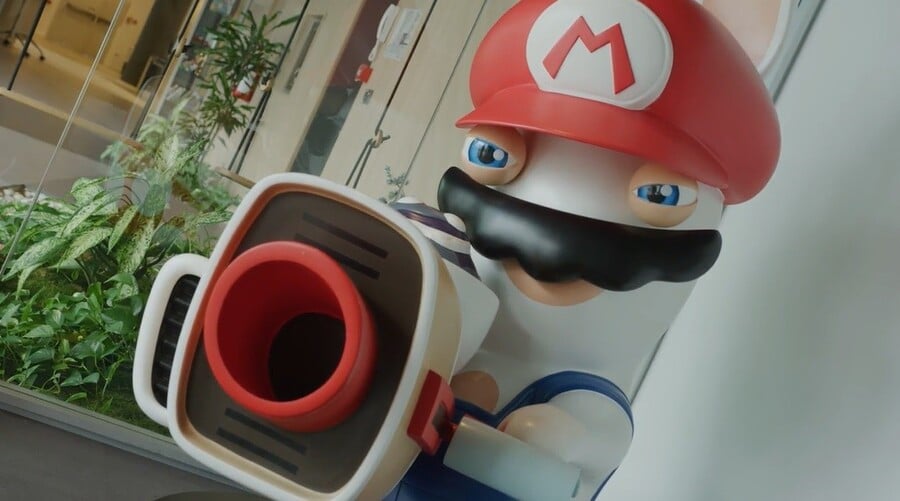
There are a lot of things we’re beginning to associate with Mario + Rabbids Sparks of Hope; surprise, joy, freedom. But perhaps the most important one is ‘change’.
Mario + Rabbids Kingdom Battle was a huge success for creative director Davide Soliani's team at Ubisoft, with the game reaching 10 million players worldwide as of 2022. And, given those numbers, Ubisoft Milan and Ubisoft Paris could've just rested on their laurels and created a solid follow-up to their first game. Instead, they are looking to the stars for a fresh shot of joy.
Ubisoft Milan recently invited us to visit its studio to get a behind-the-scenes look at the upcoming game, a sequel to the surprise 2017 hit which took Nintendo's most famous son into turn-based battle. So, now that the world around the Mario and Rabbids amalgamation has expanded, and the possibilities have become galaxy-sized, just how do Sparks of Hope's changes create a cohesive constellation?
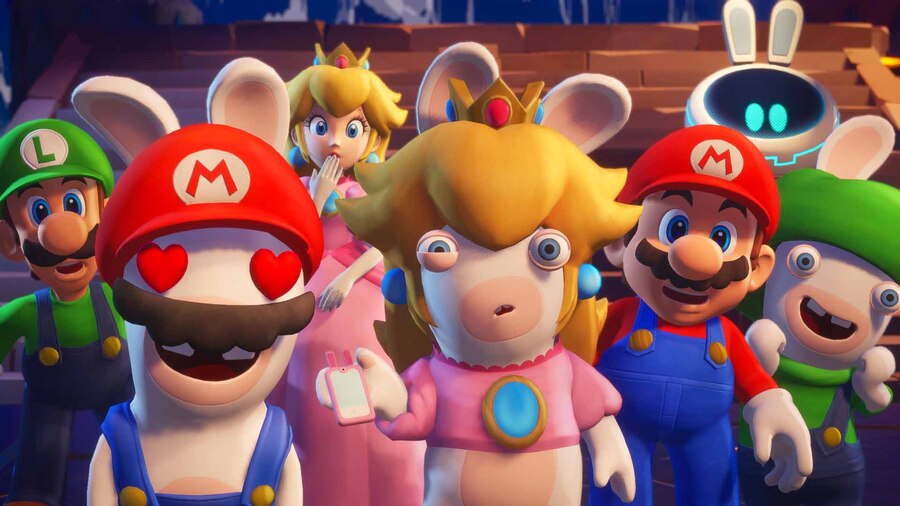
Welcome to the galaxy
As we were greeted at the studio by both developers from Ubisoft Milan and Paris, and by a few Rabbid statues who looked ready to take us out with a perfectly-timed “Bwaaa!”, we could immediately see the passion and nervous excitement on developer’s faces. Often, we see developers on stage or through video broadcasts, confidently selling their games to the world. Here, the team were shuffling around, getting presentations ready for us, and looking anxious to start.
"We've revamped everything," Xavier Manzanares, lead producer on Sparks of Hope told the room at the start of the day. From every trailer we’ve seen so far, Sparks of Hope looks to be making things bigger and better. Creative director Davide Soliani talks about taking risks with this follow-up following the success of the original, and his worry about changing a combat system which "everyone loved".
Ubisoft Milan and Paris gained a lot of trust from Nintendo with the success of the first game; Manzanares later told us, “A lot of things we were able to do in Sparks of Hope, I don't think we would've been able to do in Kingdom Battle… I guess we could do it because of trust. We shipped a game, they saw the quality, they saw the passion…”
While it feels like Ubisoft Milan is the beating heart of the project, it's part of a much larger team. Along with Paris, the studio is supported by Chengdu, Pune, and Montpellier. Manzanares revealed that these studios were there to take on multiple things, such as entire animations, and oftentimes entire planets. With all of these additional hands, it might have been easy for everything to feel disjointed, but it’s clear that isn’t the case.
The final frontier
Visually, despite being set in space, it’s clear that this is still a Mario + Rabbids game. Mauro Perini, lead art director, started by showing how subtle, small changes to the art make Sparks of Hope feel both otherworldly but also decidedly Mario + Rabbids. Perini describes the first game’s style as “toybox”, and the team wanted to move away from that and make the visuals "sharper, edgier, a bit crazier" with some anime-style inspirations. And, when watching things like Edge's reveal, and looking at the concept art, the latter is extremely obvious.
Lead artist Fabrizio Stibiel showed us what many of these tweaks were like in action – more painterly visuals give the game a more ethereal look. The rounder trees and softer grasslands become a bit more jagged, more “crazy” in Sparks of Hope. Stibiel says that the team worked in the old visual style first, before changing things to match the mood they were going for. They’re things you might not notice when playing the game in isolation, but when you check out the two different styles side-by-side, it feels very different. Even the more-visible skybox, with more texture, movement, and a wider range of colours, gives the follow-up a very different look.
With the variety of planets and landscapes that were shown off during the day, Super Mario Galaxy kept springing to mind. Snowy tundras, autumnal clearings, and sparkling beaches, all with a mystical, otherworldly feel to them. Asking Manzanares about the game’s connection to Galaxy, he revealed it came into the conversation near the beginning of development and that the team brought the two Wii games into the office. However, they soon realised they were losing sight of their own vision. “It's our universe, it's something new," he says. "And making references and using too many Galaxy elements is okay, as long as you have a logical explanation for that.”
Sparkle and shine
Things like the Sparks – a melding of Rabbid and Luma – are the perfect example of this fusion that makes absolute sense in this world. Unusual, adorable, and definitely a little goofy, these little creatures provide the Heroes with skills in battle, but all of them have unique personalities and designs. And they weren’t easy to get right, according to Manzanares. Pointing at the game’s promotional art, he tells us “...this is actually version 25 of the Sparks!”
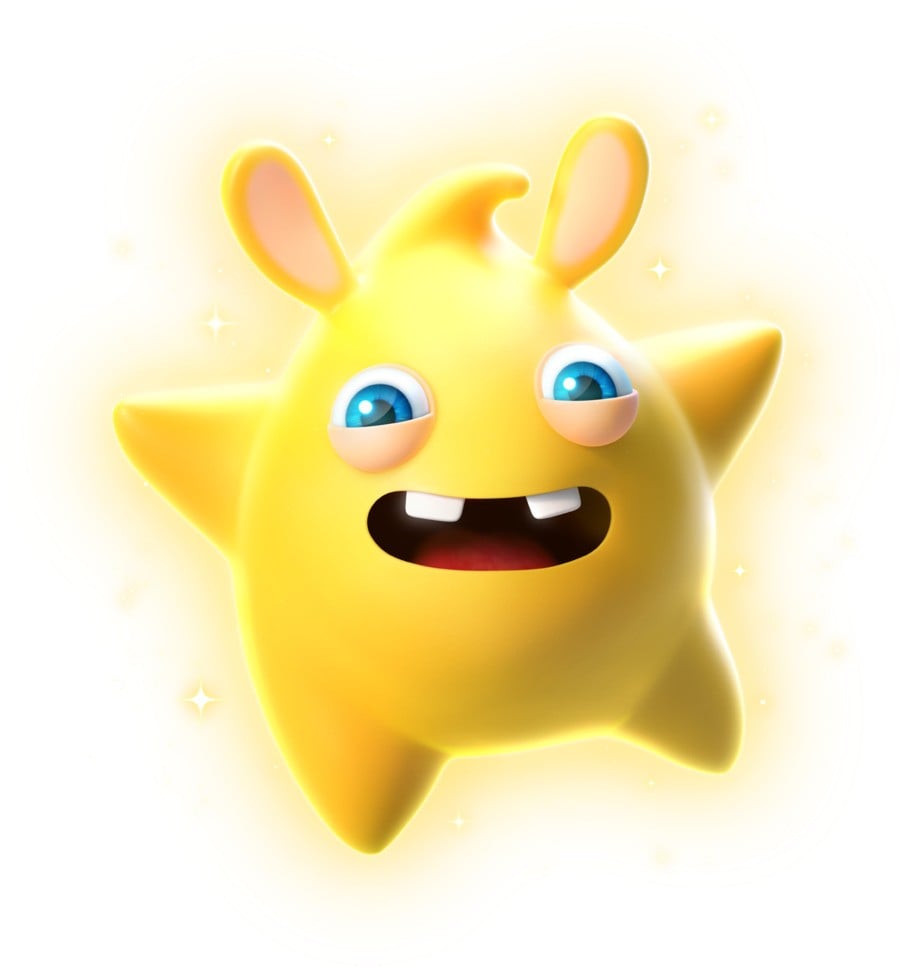
The Sparks came about as an idea of evolving the first game’s combat system, which focused a lot more on weapons, and “sometimes the weapons you liked visually, well, you have to change it because you found a new weapon with a super effect or with stats that were better.” We got to see them in action, equipped to the Heroes in battle, and watched them unleash AOE attack magic or apply elemental attributes to a character's weapon. The Sparks, then, are a step away from traditional weapons, but they needed to fit into the world and not just function as ‘skills’, so the creative process took a long time.
Other Rabbid characters also took time to get right. Maybe our favourite part of the tour was with the art team, where concept artists were scribbling down ideas around a table, and we could see tons of concept art for the game. Valentina Moscon shows us many of the levels and character designs she's worked on throughout the process with two contrasting characters, a forest spirit and a lumberjack.
From our perspective, the team's art and animation process feels incredibly humble and old-school. From animators acting out scenes in person to nail the character’s personality, to their mood and tone being captured perfectly both in and out of combat, every inch of the characters has been carefully crafted and considered. And, Edge in particular was a highlight. “‘How can a Rabbid look cool?’” animation director Marco Renso remembers reading online.
Soliani describes Edge as the “most advanced proof of our intention to evolve the Rabbids as characters.” She’s very punk rock, with spiky hair and an unusual colour combination. She’s a mixture of different references, from Beserk’s Guts to Final Fantasy VII’s Cloud Strife, Manzanares tells us with a laugh. So not only is there a huge splash of strategy and tactical elements to the game, but now there’s a little dash of the JRPG in here.
Also adding to that JRPG feel are the Rabbid voices, which stood out when we previewed the game a few weeks ago. Audio director Romain Brillaud reveals that the idea to give the characters voices came up very early. "We thought .. we need them to have voices, to have their identity. They need their own voice, they also need their own language because… of the new narration that we want to bring to the game”.
There's a story here, and it needed to be told, but that silliness still needed to be there: Rabbid Mario, for instance, is very deep-voiced and has a bit of an overconfident edge, while Rabbid Peach is very sarcastic. And this had to be mixed in with all of the usual Rabbid quirks and yells. “It's a matter of balance,” Romain says. “You have to record the original Rabbid from time to time being really silly, because it's still there, it can come up any time!”
The Guardians of the Galaxy
This is also where the Wardens, the guardians of the planets, come in.
Wardens are both essential to the story, but also offer up sidequests and reasons to revisit the planets. We were shown Captain Orion, a pirate warden who looks after the snowy planet of Pristine Peaks. Sailing the seas of the starry ocean, he’s big, bulky, and has a booming voice and personality to match. Augie, Beacon Beach’s Warden, tries his best to look like a Greek emperor, but his cardboard accessories and goofy grin betray him. Their stories are told in unique visual styles – Greek vase paintings, street art, and stained glass panels were just a few examples we saw. They even acknowledge your actions and change how they speak to you throughout the game.
Alongside the Wardens, we got to see “before” and “after” scenes of Beacon Beaches from the visual effects team, one with Darkmess, and another post-Darkmess. In the former, the skies are grey and the scenery is muted. Even the puddles emphasise that this is a place that needs help. Next to it was the same shot, the same landscape, in a much sunnier view. The sand is golden and the Greek architecture is much more prominent. Manzanares reveals that Okami served as the inspiration for this visual change: the team wanted to give “progression as a reward for the players”, but not just in terms of exploration or skills, but visually.
Sound also helps with this. Brillaud wanted the change in visuals to be matched in the music. The audio team highlighted the different noises of critters compared to the sound the leaves and weapons make depending on their properties or their surroundings. Brillaud says of this process: “we crafted every sound and every character and every tiny creature… every time [the world] changes visually… the sounds need to be really, really tight to what you see.” The change between environments, and the change in mood, are all enhanced by the harmony between the visuals and the sounds.
Move free
One section of the presentation was dedicated entirely to combat. Sparks of Hope tosses grid squares and menus to one side (largely), and instead allows you to move your Heroes around a limited area per turn, and activate attacks at the press of a button.
This change came from “the need and desire to give the player freedom”. From the programming team, we saw how small animation changes made weapon effects look more unique and feel more powerful, with Rabbid Peach's three-bullet shot coming from three different angles. So again, every element has been combed over, fine-tuned, and refined in the sequel.
Soliani admits that it was difficult to find a way to implement free movement. “In real-time, there are a completely new set of challenges that you are giving to the player, that even as the designer you are discovering for the first time.” Things like no longer being able to cancel an action were tough discoveries, but the fact there’s no timer on your movement also means there’s no pressure.
However, it was clear there is time to think — time to strategize. "Plan as you go" is a phrase that the level design team used a lot, and Soliani backs this up. “That's what I loved about keeping Spark of Hope turn-based because you can keep your time, you can take your time.”
Having seen more of the game, the title of this movement-focused segment – “Designing a tactical game for all” – resonated. Sparks of Hope is positioned as an extremely accessible jump into the turn-based tactical genre, which is something the team is extremely proud of. Difficulty options are present; for each planet, you can select its initial difficulty and change it whenever you want. Additionally, you can also adjust parameters within that difficulty option. Soliani used Celeste’s ‘Assist Mode’ as an example, saying “you can basically create your own recipe with the level of difficulty”. Enemy health, weapon potency, regen – all sorts of things can be tweaked.
Inspiration for this came from the community and families, Soliani says. While there are super-passionate fans of Kingdom Battle who wanted “more”, younger players and families were the opposite. Soliani, with a smile on his face, tells us about families coming together to play games, as “a moment to spend time together with people you love”, but recognises that Kingdom Battle may not have accommodated that setting. So, the ability to “tailor the experience to your needs” was added.
It's-a-Goomba!
Outside of the Mario Galaxy references throughout, the wider Mario 'brand' is much more apparent. Bowser and Rabbid Rosalina both came into the game in different ways. Manzanares says that the team worked on the “archetype” of a big, strong, AOE-focused attacker. Bowser fit that description perfectly, and Nintendo, too, “saw how closer Bowser could be to the archetype and how fitting it would be”. And so the team worked on making him fit into the world and the gameplay.
Rabbid Rosalina was the opposite – Ubisoft wanted to bring in another outlandish Mario/Rabbid crossover, and when creating a very sleepy animation, Manzanares recalls thinking, 'Okay, we have something here, we need to go full-on'. The personality shaped the archetype this time around, with skills, movements, and animations to match.
Other Mario elements also make an appearance. This time, enemies such as Wigglers, Bob-ombs, and Goombas can all be seen in-game. But it was more than just a desire to bring in “more Mario”, says Soliani. “We have been driven not by the visuals, but by the possibility [of] who will be against us in combat.” Bob-ombs, for example, can be picked up and thrown at other enemies, exploding to deal wide AOE damage. And Goombas can be landed on or kicked down.
Even the music will be taking a touch of Mario and bringing it to the galaxy. Brillaud couldn’t show us any of the clips, or even tell us what music was being rearranged, but mentioned that an “iconic Nintendo theme” has been rearranged by returning composer Grant Kirkhope for a level where you collect fish. Legendary Nintendo composer Koji Kondo and Super Mario Galaxy co-composer Mahito Yokota supervised the soundtrack, which would be enough to make anyone nervous – even Kirkhope!
“They are too talented for me to give them directives!”
Kirkhope’s score for Kingdom Battle is brilliant, showcasing his upbeat, funky style with a sweeping orchestral score to help push the jolly, light theme of the game. But this time Kirkhope has been joined by Ori and Halo Infinite composer Gareth Coker, and Mario RPG and Kingdom Hearts legend Yoko Shimomura. With more cooks in the kitchen, there was certainly potential for disharmony.
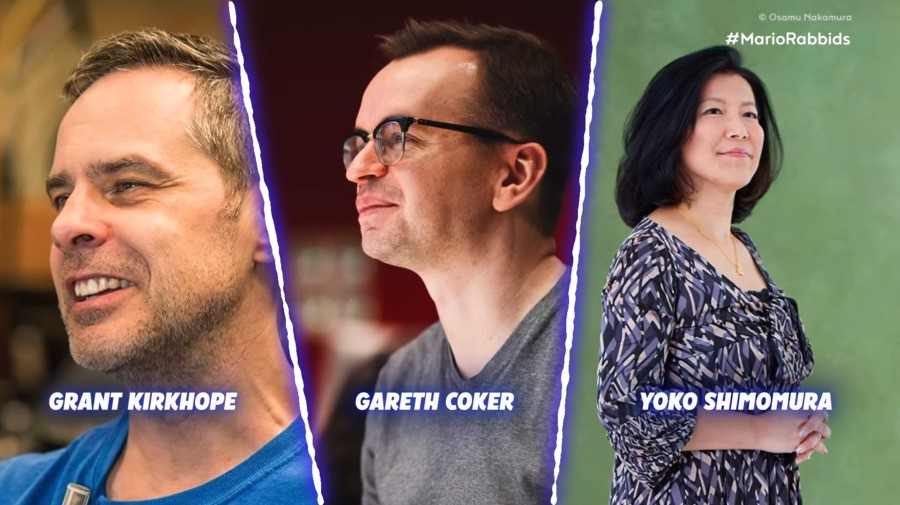
However, we're surprised with just how well all three composer’s styles blend together. In the audio clips that we listened to, Kirkhope’s Pristine Peaks piece was full of the “small joys” and little pick-me-ups you expect; Coker’s sample had a space-like feel to it, full of “complex feelings”; and Shimomura’s battle music married together the feeling of panic and the tone of springtime.
Using the same orchestra and instruments and recording all of the music in Tokyo helped Brillaud maintain harmony. That made things quite tough for scheduling, with all three composers working in different timezones, and all three also had different personalities and approaches. “Grant really likes to pitch tons of ideas and has a lot of things, and Mrs. Shimomura thinks about the piece, and then when she sends a piece, it's usually spot on, and then there's more reflection,” Brillaud shares, whereas with Coker, “it's not just the brief and what you tell him. He wants to have his hands on the game and feel the pace himself.”
To help with musical consistency, Brillaud often paired composers together per planet, so one planet would have Kirkhope and Shimomura, but the next might be Coker and Shimomura. Brillaud wanted them to get their hands on the game, understand the vision, and he says it was his job to “grab the ideas that they bring and mix them together.”

The heart of the galaxy
A lot of what we were shown throughout the day wasn’t necessarily new. Edge, Rabbid Rosalina, Bowser, the combat, the cutscenes, and the music, were all things we’ve had flashes of before. But, what did come across more than ever is the heart, the passion, the vision. And Soliani summed it up perfectly when we asked him about maintaining the joy of the first game:
“It’s not easy to create something so new and weird and funny, but it’s also about sharing the mood of the team, creating something that was making them feel good, feeling happy… it’s always a joy to come up with something that we could be proud of and our players could be happy about”
It’s certainly looking like Sparks of Hope will be just that come 20th October; what we’ve seen and played so far has put a big, soppy smile on our faces.
And, at the end of the day, it turns out the concept art team weren't just drawing Rabbid-related art — they were redesigning our lovely little logo. Those Rabbids look like they're doing the best job they can manage, with lots of shouting, we imagine! Check out the charming piece from Ubisoft below.
Our thanks to the staff and team at Ubisoft Milan for showing their work, and Xavier Manzanares, Davide Soliani, and Romain Brillaud for taking the time to speak to us.
Travel and accommodation for this studio tour were provided by Ubisoft. All interview excerpts have been lightly edited for clarity.
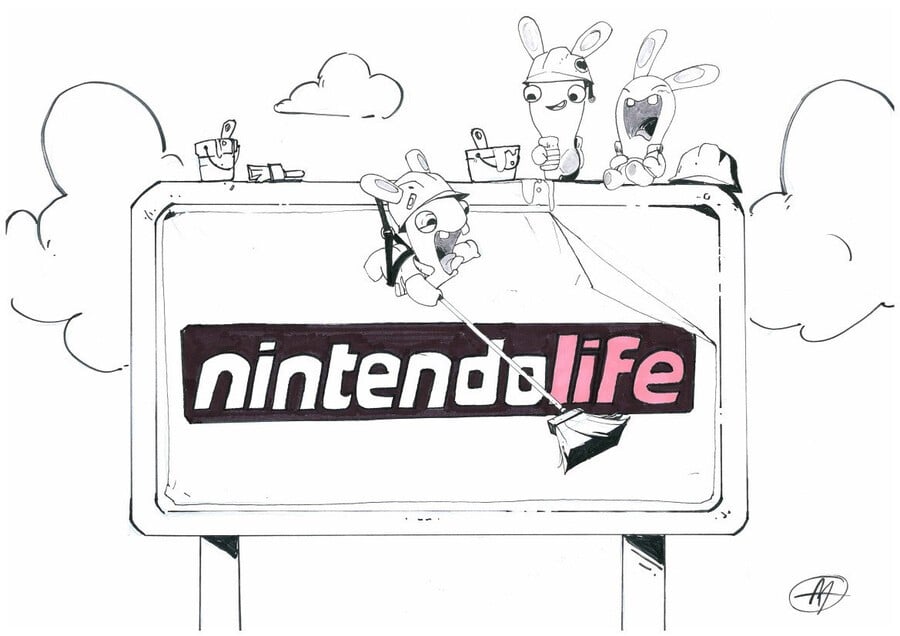





Comments 23
I'm extremely excited for this game. My only concerns are the fact that so much voice was added and that I don't like Edge as a character. She isn't Mario enough, not Rabbid enough, and not cool enough. Maybe she would have looked cool back in 1999, but here she just feels completely out of place.
Regardless, those are small nitpicks. I'm going to love this.
Loved the original, but this is not a day one buy. By this time next year, the Gold edition will be half the price of launch price, with all dlc included.
I wish the game didn't have a $30 "season pass" with speculative content attached to it. That tells me two things:
-The actual cost of the game at release is $90
-The game is releasing in an unfinished state, so physical copies are by default incomplete, and also if you want to play all it has to offer, you're better off buying/playing the game 6-12 months from now (when it will almost certainly be cheaper, too).
I bought the first one, but still haven't finished it and lost interest on account of its season pass making me feel like I bought an incomplete game souring my experience. And I'd paid full retail price for the game at release; I'd at least be less bitter about the existence of the first game's DLC if I'd picked it up the base game for the $10-$20 it regularly goes on sale for these days. So if I pick up the sequel, I'll play the waiting game.
Easy, normal and hard settings this time? = that's "for all"
I'm still not sold on the free movement bit but I have no doubt that this game will be as brilliant as the first, if not better.
Yoshi is ***** dead
My goodness, they assembled A LOT of talent for this game.
@ketrac I don't know if that's a very common thing with Nintendo games. PS and Xbox, for sure.
@tseliot Mario rabbids is a Ubisoft game.
Just played the Donkey Kong DLC for kingdom battle and really enjoyed myself. So am looking forward to this one! Good to hear they’re trying to develop new gameplay ideas, I’m up for a slightly new/different experience
I have no interest in this game, but it's great to read such an article. You guys should get out of the office more often.
? Seems weird/boring that the influences they reference for Edge are Guts and Cloud.
Great piece here, some great talent is behind this game. Only a week away from release now, can't wait.
This sounds wonderful. The team clearly has a lot of passion around this project. I hope this does well!
"Even the music will be taking a touch of Mario and bringing it to the galaxy. Brillaud couldn’t show us any of the clips, or even tell us what music was being rearranged, but mentioned that an “iconic Nintendo theme” has been rearranged by returning composer Grant Kirkhope for a level where you collect fish. Legendary Nintendo composer Koji Kondo and Super Mario Galaxy co-composer Mahito Yokota supervised the soundtrack, which would be enough to make anyone nervous – even Kirkhope".
It's clearly not this theme, but Grant Kirkhope have made a "rearrange" for the Rosalina Observatory. We can heard it in this trailer at 1:42 😁 https://youtu.be/VHIuHMv3t88
@TrixieSparkle so if we follow your logic, Breath of the Wild, Xenoblade 2&3, Splatoon 2&3, Pokemon Sword and Shield, etc, are incomplete games because they have DLC ?
@Rykdrew there is even an invincibility mode. You can arrange a lot of thing (your health regen before battle or not, enemy threat level, etc).
@Froid12 Really? Thank you for the info!!
@Rykdrew Right?!? I read that subtitle and thought maybe they were going to talk about things like menu narration, alternate control schemes, maybe colorblindness options - you know, ACTUAL accessibility options? Super excited for a second or two.
But no, we're talking about difficulty settings.
"It's so accessible!"
with Spanish accent "You keep on using that word. I do not think it means what you think it means."
@JasmineDragon there is colorblindness option and other option for motion sickness.
@Froid12 Well, that's something. Good to know.
@Froid12
I mean, in every one of those cases, if you have a physical copy of the game and lend it to a friend, sibling, etc., they absolutely do not have the complete version of the game without purchasing DLC for their account. So yes, without the DLC being included, the games are incomplete. It's not much different from the many Switch collections where only half the collection is on the physical cart, and the other half of the collection is downloadable content with a single use redemption code (a not so subtle way certain companies discourage used game sales, that simultaneously makes the physical carts effectively worthless).
Of those examples you provided, the Splatoon series in particular presents itself as a "games as a service" model, and makes no effort to hide the fact that the games launch in an incomplete state, just in general. They openly advertise it as such.
There's a reason games like Sword and Shield, as well as Breath of the Wild, launch physical copies that have the DLC on the cart in some regions, why there's a demand for them, and why people outside those regions are willing to import them.
Out of your provided examples, Xenoblade 2 is the cleanest one, as they actually had enough confidence in their DLC to release it as its own game, that could be bought separately from the main game entirely if someone chooses to do so. It hardly even qualifies as DLC at that point, it's literally a separate game.
You can enjoy games, but still call things out for what they are.
@ketrac And it's still a damn Nintendo only game. Way off my point.
Show Comments
Leave A Comment
Hold on there, you need to login to post a comment...